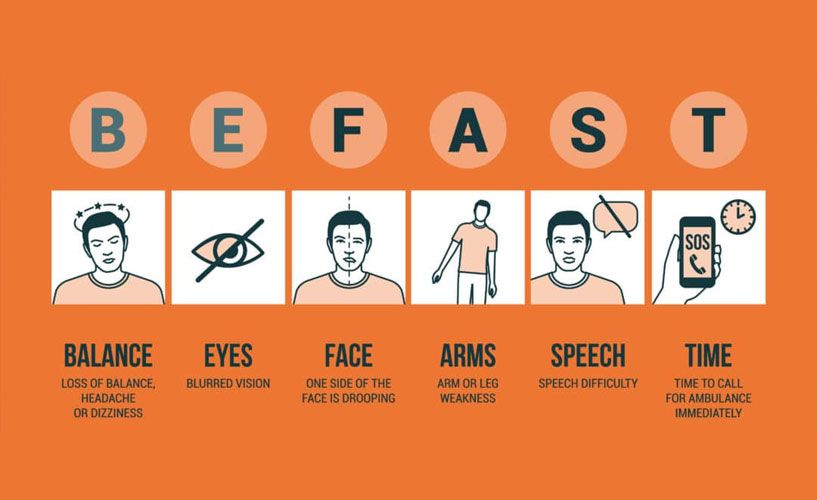Be Fast To Identify A Stroke And Save A Life

What Is A Stroke?
Stroke is a disease that affects the arteries leading to and within the brain. It occurs when a blood vessel that carries oxygen and nutrients to the brain is either blocked by a clot or bursts. When this happens, part of the brain cannot get the blood and oxygen it needs, so the brain cells die.
There Are 3 Types Of Strokes:
Ischemic Stroke
Most strokes are ischemic strokes. They make up about 87% of all strokes each year in America. Ischemic strokes happen when the blood flow through the artery that supplies oxygen-rich blood to the brain becomes blocked. This leads to brain damage or death of brain cells.
Transient Ischemic Stroke
A Transient Ischemic Stroke is usually called a “mini stroke.” In a transient ischemic stroke, blood flow to the brain is blocked for only a short time (usually about 5 minutes). This type of stroke serves as a warning sign of a future stroke.
Hemorrhagic Stroke
A hemorrhagic stroke happens when an artery in the brain leaks blood or ruptures. The leaked blood puts too much pressure on brain cells, which damages them. Health conditions like high blood pressure and aneurysms can cause a hemorrhagic stroke.
The brain is one of the most complex organs in the body that controls various body functions. If a stroke occurs and blood flow can’t reach an area of the brain that controls a certain body function, that part of the body won’t work as it should.
Stroke is the leading cause of disability in America and the 5th leading cause of death. The biggest hurdle of strokes is recognizing the symptoms and understanding that strokes are medical emergencies. The faster a person recognizes the symptoms of a stroke and gets medical attention- the greater the chance a life can be saved.
B.E. F.A.S.T.
Use the letters in “B.E. F.A.S.T.” to spot early warning signs of a stroke and know when to call 9-1-1.
Balance:
Is there a sudden loss of balance or coordination? Is the person leaning to the side or staggering when walking?
Eyes:
Is there sudden blurred of double vision or sudden, persistent vision trouble?
Face:
Does one side of the face droop or is it numb? Ask the person to smile. Is the person’s smile lopsided or uneven?
Arms:
Is one arm weak or numb? Ask the person to raise both arms. Does one arm drift downward or feel heavy?
Speech:
Sudden difficulty in speaking or understanding. Does the person have slurred speech? Ask the person to say/repeat a simple phrase.
Time:
Call 9-1-1 for immediate medical attention if you notice one or more of these signs. Take note of when the symptoms began.
Quick action is key to treatment for strokes. Be informed, vigilant, and if you think you or someone else might be having a stroke, BE FAST.
Townsen Memorial Is Here For You
At Townsen Memorial, our emergency room provides 24/7 around the clock care with no wait times. Our innovative facilities and experienced staff mean you’ll be comfortable during your stay and that you can trust us with your medical care. We are located in Humble, TX off of FM 1960 and Highway 59. If you have any questions visit our website or call 1-877-494-9487.